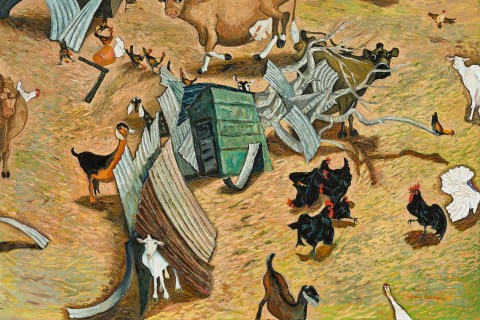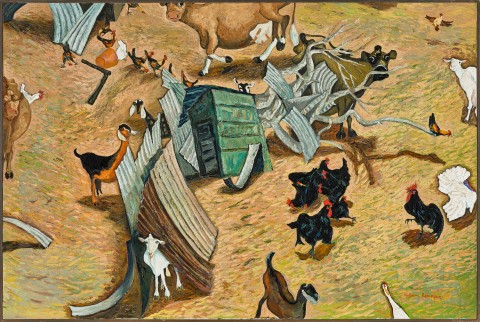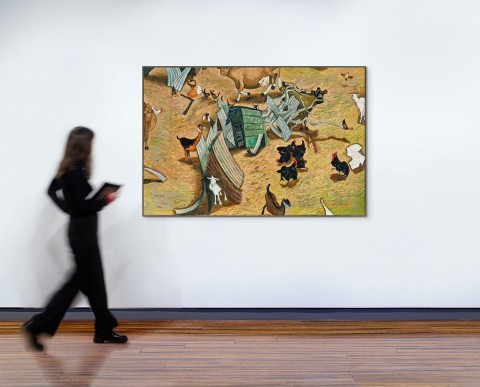BIRKDALE FARM CONSTRUCTION WITH AUSTRALORPS, 1982 - 83
WILLIAM ROBINSON
oil on canvas
122.0 x 183.0 cm
signed lower right: William Robinson
bears inscription verso: FARMYARD CONSTRUCTION
Ray Hughes Gallery, Brisbane
Private collection
Martin Browne Fine Art, Sydney
Dr Peter Elliott AM, Sydney
The Peter Elliott Collection, Mossgreen, Sydney, 30 August 2015, lot 7
The Estate of the Late Alan Cardy, Sydney
William Robinson, Ray Hughes Gallery, Brisbane, 1985 (as ‘Birkdale Farm Construction’)
William Robinson, The Revelation of the Landscape, S. H. Ervin Gallery, Sydney, 11 January - 2 March 2003 and Mornington Peninsula Regional Gallery, 1 April – 18 May 2003, cat. 1
William Robinson: The Farmyards, William Robinson Gallery, Queensland University of Technology, Brisbane, 23 July 2013 - 8 June 2014
Art and Australia, 1984, vol. 21, no. 3, p. 405 (illus. as ‘Birkdale Farm Construction, 1983’)
Watters, J., William Robinson, The Revelation of the Landscape, National Trust of Australia, Sydney, 2003, p. 40
Low, L. A., 'Wreck 'n' roll', Sydney Morning Herald, Sydney, 1 February 2003, p. 11
Fry, G., The Peter Elliott Collection of Australian Art, The Beagle Press, Sydney, 2013, cat. 110, pp. 114 - 115 (illus.)
Robinson, W., William Robinson: The Farmyards, Queensland University of Technology, Brisbane, 2013, p. 34 (illus.)
William Robinson’s farmyard paintings are central to his development as a painter because they form an important stepping stone toward his unique view of the Australian landscape. Birkdale Farm Construction with Australorps, 1982 – 83, is one of the major examples that form the core of this important series. Robinson’s ‘farmyards’ may be seen as microcosms of his world at the time they were created. The usual menagerie of characters are present in the work: Josephine the cow, goats, ducks and chooks (Australorps in this instance) make up the composition. These animals were probably closer to family pets than anything else and Robinson imbues each with a distinct character and personality. At times the arrangements mischievously reflect the machinations of the Brisbane art scene.
The playful, political allusions may also reflect the internal politicking of the art school staff room where he worked as a teacher. In his own words and with an Orwellian overtone, Robinson’s depictions give ‘…some feeling of the relationship of man to domestic animals and also the relationship that exists within the world of these animals’.1
Of course, the whimsical nature of Robinson’s farmyards, along with his hidden innuendo belie the seriousness of these works, for his farmyard series are dissertations on the values of Western painting. The primary influence of modern masters such as Cézanne, Braque, Bonnard and Morandi are all present and each informs the structure of Robinson’s compositions in their own way. We can also assume the influence of the Australian artist Ken Whisson, with whom Robinson shared the walls of the Ray Hughes Gallery many times during the 1970s and 80s. Whisson’s robust distortion of pictorial space during the 1970s culminated in unconventional arrangements, which arguably helped Robinson lay the groundwork for his distorted farmyard paintings.
Robinson’s dealer in these early years was Ray Hughes (1946 – 2017) whose commitment to Robinson was total, verging on obsessive. At times he would violently defend the artist’s importance in the face the cool curatorial currents of the day. It was a winning combination of complimentary opposites; Robinson presented as the shy painter quietly working away on his hobby farm, while the urbane, bon vivant Ray Hughes lead from the front showcasing the work. Eventually the artworld and curators fell into line and Robinson’s work became highly sought-after. Hughes’ efforts and belief in the artist paid off in spades as Robinson was now selling out exhibitions, winning major prizes and living on the proceeds of sales, which enabled him to retire from teaching and to begin painting full time. By then Ray Hughes’s gaggle of loyal collectors, most notably Dr Colin Laverty and Dr Peter Elliott, had well-stocked holdings of the artist’s works. The current work was central to Elliott’s collection and took pride of place alongside Whiteley and Williams in his Potts Point home for decades before it was acquired by Alan Cardy in 2015.
Major Robinson farmyard paintings such as Birkdale Farm Construction with Australorps will continue to be a touchstone to a time when Robinson was searching for a language that would eventually alter the way we view the Australian landscape through the soaring, majestic landscapes for which the artist became most well-known.
1. Robinson, W., in conversation with the Gold Coast City Art Gallery, 1998, cited in Walsh, J., ‘Goats, Cows and Chooks: The Painters Farmyard’, in Seear, L. (ed.), Darkness and Light: The Art of William Robinson, Queensland Art Gallery, Brisbane, 2001, p. 72
HENRY MULHOLLAND


